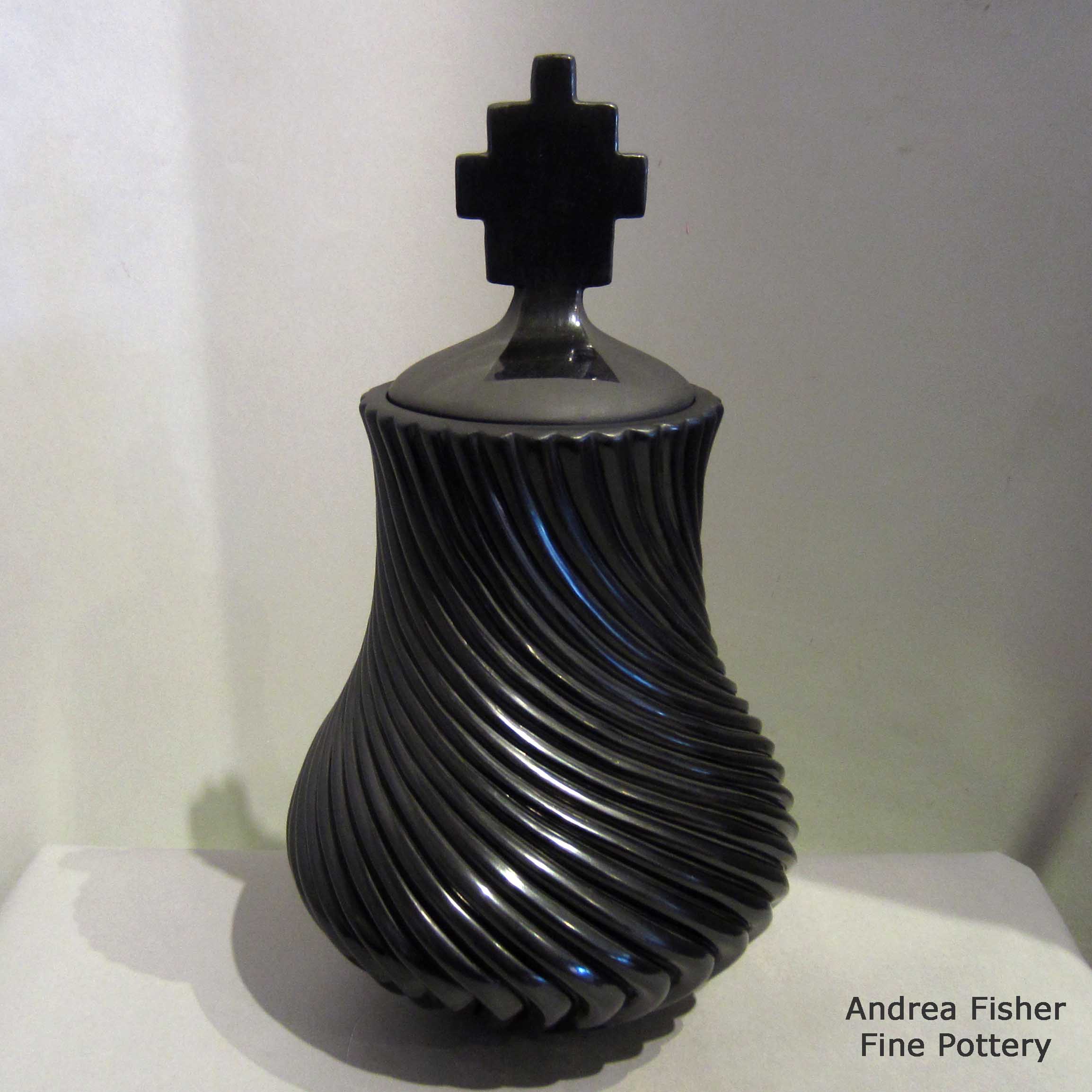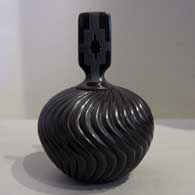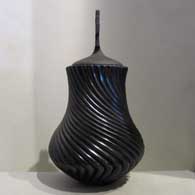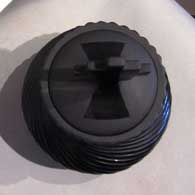
Santa Clara
$ CALL
anscg5341
Lidded, polished black jar carved with swirl design
11.5 in H by 6.5 in Dia
Condition: Excellent
Signature: Nancy Youngblood 2006
Date Created: 2006
Tell me more! Buy this piece!
(505) 986-1234 - www.andreafisherpottery.com - All Rights Reserved
Nancy Youngblood
Santa Clara
"I hope when I'm 93, I wake up every day and say I want to make a pot."
Nancy Youngblood was born to Mela and Walt Youngblood at Fort Lewis, Washington, in 1955. Due to her father's military career, the Youngblood family moved every couple years until Walt was sent to Vietnam in 1968. That is when Mela returned to Santa Clara Pueblo with their 2 kids, Nancy and Nathan. When Walt came back from Vietnam, he rejoined the family at Santa Clara.
Shortly after their return to Santa Clara, Mela decided to get serious about making pottery. The three Youngblood's started spending most of their free time with the matriarch of the family, Margaret Tafoya. Mela was a very good potter but Nancy says she learned more from Margaret. Her grandfather, Alcario, also taught her how to carve traditional Santa Clara designs into her pots.
Toward the end of high school, Nancy decided she'd rather be a painter and earned a four-year scholarship to the San Francisco Art Institute. But the world of academia was too sterile for her. Then she tried the University of New Mexico but was turned off by the faculty she had to deal with. So she went back home to find a job.
One of the first places she applied at was Packard's, a department store (now closed) on the Plaza in Santa Fe. Al Packard, the owner, knew her family and asked why she wasn't making pottery. About that same time her father decided that if she wasn't going to finish her education, he wasn't going to keep supporting her. So she became a starving artist for a while. She moved into a family house with her aunt, Shirley Cactus Blossom Tafoya. Shirley was just learning to be a potter, too. The stories about Nancy and a friend selling miniature pots at Santa Fe Indian Market for $15-$25... they're true. Nancy and Shirley did so well during Indian Market they kept making and selling those small pots for months after.
Nancy then married her high school sweetheart and supported them as he went through medical school. Soon after he finished med school and started his practice, their marriage broke up.
Nancy didn't stop then, she dedicated herself to her pottery. She put in 12-to-16 hour days, seven days a week for more than a decade. Then things started to click for her. Nancy evolved the melon jar into multiple forms, adding ribs, curves and lids. She got her firing practice down so her black pots were gorgeously glossy black pots. Awards poured in and her work was being shown in galleries around the country. Every year more copycats popped up. It didn't matter: her work was simply too good for them to copy.
Then Nancy met an engineer, fell in love and married again. One of the first things he did was teach her to ride a motorcycle. Then when they went for a ride, they had "his-and-hers" Harleys.
Over the years Nancy amassed nearly 300 ribbons and awards for her work. She likens the making of pottery to the playing of a musical instrument, saying "the more you practice, the better you become." Nancy also credits her record on the fact she always uses traditional methods, right down to praying and using cornmeal before getting the clay and sand and praying before each firing.
She leaves as little to luck and chance as possible but knows there is some point in the process where "the spirit of the Clay Mother takes over and you learn to leave well enough alone. Something larger takes command and then you have to let go and trust the process. The fire decides its destiny."
Some Recent Awards earned by Nancy
- 2023 Santa Fe Indian Market, Classification II Division A - Traditional unpainted pottery, Best of Division
- 2023 Santa Fe Indian Market, Classification IIA, Category 504 - Pins and Pendants, First Place
- 2023 Santa Fe Indian Market, Classification IIA, Category 506 - Boundary, Second Place
Santa Clara Pueblo

Ruins at Puye Cliffs, Santa Clara Pueblo
Santa Clara Pueblo straddles the Rio Grande about 25 miles north of Santa Fe. Of all the pueblos, Santa Clara has the largest number of potters.
The ancestral roots of the Santa Clara people have been traced to the pueblos in the Mesa Verde region in southwestern Colorado. When that area began to get dry between about 1100 and 1300, some of the people migrated to the Chama River Valley and constructed Poshuouinge (about 3 miles south of what is now Abiquiu on the edge of the mesa above the Chama River). Eventually reaching two and three stories high with up to 700 rooms on the ground floor, Poshuouinge was inhabited from about 1375 to about 1475. Drought then again forced the people to move, some of them going to the area of Puye (on the eastern slopes of the Pajarito Plateau of the Jemez Mountains) and others to Ohkay Owingeh (San Juan Pueblo, along the Rio Grande). Beginning around 1580, drought forced the residents of the Puye area to relocate closer to the Rio Grande and they founded what we now know as Santa Clara Pueblo on the west bank of the river, between San Juan and San Ildefonso Pueblos.
In 1598 Spanish colonists from nearby Yunque (the seat of Spanish government near San Juan Pueblo) brought the first missionaries to Santa Clara. That led to the first mission church being built around 1622. However, the Santa Clarans chafed under the weight of Spanish rule like the other pueblos did and were in the forefront of the Pueblo Revolt of 1680. One pueblo resident, a mixed black and Tewa man named Domingo Naranjo, was one of the rebellion's ringleaders. When Don Diego de Vargas came back to the area in 1694, he found most of the Santa Clarans on top of nearby Black Mesa (with the people of San Ildefonso). An extended siege didn't subdue them so eventually, the two sides negotiated a treaty and the people returned to their pueblo. However, successive invasions and occupations by northern Europeans took their toll on the tribe over the next 250 years. The Spanish flu pandemic in 1918 almost wiped them out.
Today, Santa Clara Pueblo is home to as many as 2,600 people and they comprise probably the largest per capita number of artists of any North American tribe (estimates of the number of potters run as high as 1-in-4 residents).
Today's pottery from Santa Clara is typically either black or red. It is usually highly polished and designs might be deeply carved or etched ("sgraffito") into the pot's surface. The water serpent, ("avanyu"), is a traditional design motif of Santa Clara pottery. Another motif comes from the legend that a bear helped the people find water during a drought. The bear paw has appeared on their pottery ever since.
One of the reasons for the distinction this pueblo has received is because of the evolving artistry the potters have brought to the craft. Not only did this pueblo produce excellent black and redware, several notable innovations helped move pottery from the realm of utilitarian vessels into the domain of art. Different styles of polychrome redware emerged in the 1920's-1930's. In the early 1960's experiments with stone inlay, incising and double firing began. Modern potters have also extended the tradition with unusual shapes, slips and designs, illustrating what one Santa Clara potter said: "At Santa Clara, being non-traditional is the tradition." (This refers strictly to artistic expression; the method of creating pottery remains traditional).
Santa Clara Pueblo is home to a number of famous pottery families: Tafoya, Baca, Gutierrez, Naranjo, Suazo, Chavarria, Garcia, Vigil, Tapia - to name a few.



Santa Clara Pueblo at Wikipedia
Pueblos of the Rio Grande, Daniel Gibson, ISBN-13:978-1-887896-26-9, Rio Nuevo Publishers, 2001
Upper photo courtesy of Einar Kvaran, Creative Commons Attribution-Share Alike 3.0 Unported License
Copyright © 1998-2024 by



